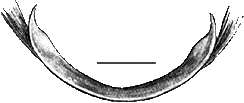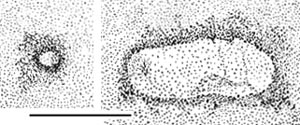Oh my goodness! Unless you are a Tree of Life developer,
you really shouldn't be here. This page is part of our beta test site, where we
develop new features for the ToL, often messing up a thing or two in the
process. Please visit the official version of this page, which is available
here.
Opisthoteuthis persephone: Description Continued
Richard E. Young and Michael Vecchione
- Eyes
- "...rather small and inconspicuous."
- Funnel
- Slender; funnel organ a pair of small, oval pads.

Click on an image to view larger version & data in a new window

Figure. Funnel laid open to show funnel organ of O. persephone. Drawing from Berry (1918).
- Fins
- "...minute, tenuous... ."
- Gills
- Six primary lamellae on one side and 6 plus one poorly developed additional lamella on other side.
- Optic lobes and nerves
- Unknown
- Digestive system
- Digestive gland bilobed (O'Shea, 1999).
- Beaks
- Upper beak with a "distinct angle along each outer side of the beak at the shoulder.".

Click on an image to view larger version & data in a new window

Figure. Lateral view of lower (left) and upper (right) beaks of O. persephone. Drawings from Berry (1918).
- Shell
- Shell with broad U-shape.
- Saddle with a posterior groove.

Click on an image to view larger version & data in a new window

Figure. Dorsal view of shell of O. persephone. Drawing from Berry (1918).
- Pigmentation
- Aboral surfaces nearly colorless or with a light dirty gray but with traces of a superficial membrane lightly pigmented with streaks of brown.
- Oral surfaces superficial integument colorless and transparent. Deeper layer dark bluish slate but paler along the arms and over a ring-like zone a little distance from mouth.
- Suckers and cirri light yellowish brown.
- Areolae present: each with small, clear central area. Overall, areolae very small.

Click on an image to view larger version & data in a new window

Figure. Areolae of O. persephone. Left - areola in contracted state from small octopod. Right - areola in expanded state, holotype. Scale bar is 1 mm. Drawings from Berry (1918).
- Measurements and counts
| Sex | ? Holotype | ? | ? |
| Spread (arm tip to arm tip), mm | 330 | 225 | 170 |
| Fin span | 75 | - | - |
| Fin length | 20 | 15 | 15 |
| Fin width | 14 | 7 | 6 |
| head width | 50 | 40 | 35 |
| Arm I, length (right/left) | 165/150 | 110/110 | 80/80 |
| Arm II, length | 160/160 | 115/115 | 85/85 |
| Arm III, length | 175/170 | 125/120 | 90/75+ |
| Arm IV, length | 165/165 | 125/110 | 90/90 |
| Diam. sucker no. 5, arm I | 2+ | 2 | 1.1 |
| Depth web sector A | 100 | 80 | 60 |
| Depth web sector C | 105 | 85 | 60 |
| Depth web sector E | 115 | 85 | 60 |
These measurements and counts are from Berry, 1918. Comments
The above description is taken from Berry (1918) except where otherwise noted.
References
Berry, S.S. 1918. Report on the Cephalopoda Obtained by the F.I.S. "Endeavour" in the Great Australian Bight and Other Southern Australian Localities. Biological Results of the Fishing Experiments carried on by the F.I.S. "Endeavour", 1909-1914, 4(5):201-298.
O'Shea, Steve. 1999. The Marine Fauna of New Zealand: Octopoda (Mollusca: Cephalopoda). NIWA Biodiversity Memoir 112: 280pp.
About This Page

University of Hawaii, Honolulu, HI, USA

National Museum of Natural History, Washington, D. C. , USA
Page copyright © 2002 and
 Page: Tree of Life
Opisthoteuthis persephone: Description Continued
Authored by
Richard E. Young and Michael Vecchione.
The TEXT of this page is licensed under the
Creative Commons Attribution-NonCommercial License - Version 3.0. Note that images and other media
featured on this page are each governed by their own license, and they may or may not be available
for reuse. Click on an image or a media link to access the media data window, which provides the
relevant licensing information. For the general terms and conditions of ToL material reuse and
redistribution, please see the Tree of Life Copyright
Policies.
Page: Tree of Life
Opisthoteuthis persephone: Description Continued
Authored by
Richard E. Young and Michael Vecchione.
The TEXT of this page is licensed under the
Creative Commons Attribution-NonCommercial License - Version 3.0. Note that images and other media
featured on this page are each governed by their own license, and they may or may not be available
for reuse. Click on an image or a media link to access the media data window, which provides the
relevant licensing information. For the general terms and conditions of ToL material reuse and
redistribution, please see the Tree of Life Copyright
Policies.


This page is a note that is attached to a
leaf of the Tree of Life.
ToL notes provide brief accounts of characteristics, short summaries,
commentaries, media files, taxonomic information, or identification tools
for a given group of organisms.
For a more detailed explanation of the different ToL page types, have a look at the
Structure of the Tree of Life page.
close box
Page Content
articles & notes
collections
people
options
Explore Other Groups
other Opisthoteuthis
containing groups









 Go to quick links
Go to quick search
Go to navigation for this section of the ToL site
Go to detailed links for the ToL site
Go to quick links
Go to quick search
Go to navigation for this section of the ToL site
Go to detailed links for the ToL site